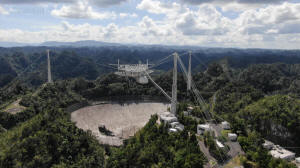Massive Puerto Rico telescope featured in James Bond movie collapses
 Send a link to a friend
Send a link to a friend
 [December 02, 2020]
By Joey Roulette [December 02, 2020]
By Joey Roulette
(Reuters) - A massive radio telescope at
Puerto Rico's Arecibo Observatory - one of the world's largest -
collapsed on Tuesday after sustaining severe damage since August,
officials said, following 57 years of astronomical discoveries.
The deteriorating telescope's 900-ton instrument platform, suspended by
cables 450 feet (137 meters) above a 1,000-foot-wide (305 meters)
bowl-shaped reflector dish, fell on Tuesday morning, the U.S. National
Science Foundation said. No injuries were reported, it added.
The telescope - which received radio waves from space - had been used by
scientists around the world to hunt for possible signatures of
extraterrestrial life, study distant planets and find potentially
hazardous asteroids. It also gained fame after pivotal scenes in the
1995 James Bond film "GoldenEye" starring Pierce Brosnan were shot
there.

Two cables supporting the reflector dish had broken since August,
causing damage and forcing officials to close the observatory as
engineering firms retained by the University of Central Florida, which
manages the observatory, studied ways to repair the damage.
In November, the engineering reviews led the NSF and the university to
conclude that efforts to repair the structure would be too dangerous and
that it would have to be demolished.
The NSF said that initial findings indicated that the top section of all
three of the telescope's support towers broke off and that as the
instrument platform fell, the telescope's support cables also plummeted.
[to top of second column]
|

The Arecibo Observatory space telescope, which was damaged in August
and in November from broken cables which tore holes in the
structure, is seen in Arecibo, Puerto Rico November 7, 2020. Picture
taken November 7, 2020. UCF/Handout via REUTERS

The observatory also includes other scientific assets such as a
40-foot (12-meter) telescope used for radio astronomy research and a
facility used to study the Earth's upper atmosphere and ionosphere.
The observatory's learning center, located next to the telescope,
sustained significant damage from falling cables, the NSF said.
"We are saddened by this situation but thankful that no one was
hurt," NSF Director Sethuraman Panchanathan said in a statement.
"Our focus is now on assessing the damage, finding ways to restore
operations at other parts of the observatory, and working to
continue supporting the scientific community, and the people of
Puerto Rico."
The NSF said it will authorize the university to continue paying
Arecibo staff and to come up with a plan to continue research at the
observatory. The agency said it has not determined the cause of the
initial cable failure in August.
(Reporting by Joey Roulette in Washington; Editing by Will Dunham)
[© 2020 Thomson Reuters. All rights
reserved.] Copyright 2020 Reuters. All rights reserved. This material may not be published,
broadcast, rewritten or redistributed.
Thompson Reuters is solely responsible for this content.
 |